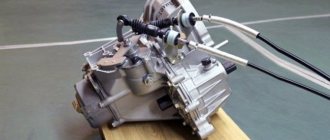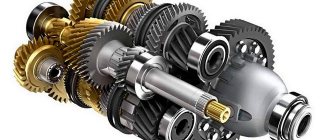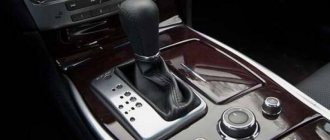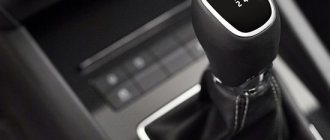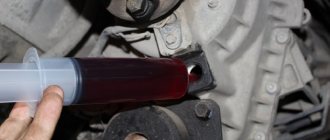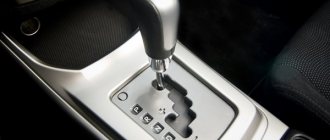Today I’ll tell you how to switch from manual to automatic. Although many car owners find it more difficult to drive a car with a manual transmission than with an automatic transmission. In most cases, problems arise among new car enthusiasts and girls who used manual transmission before switching to automatic transmission.
Write in the comments, have you had any experience of switching from a manual to an automatic? Or do you only drive your car automatically?
What is the difference between an automatic and a manual?
Everyone knows that to change gears on a manual transmission, a special device was invented - a clutch, which is necessary to break the mechanical connection between the gearbox and the car's engine. In an automatic, this unit is absent, and the driver has only two pedals under his feet.
The new switching method means completely different fuel consumption. In this situation, manual transmission benefits significantly, since the driver himself chooses the gear in which fuel consumption will be significantly less.
To control the switching, a special computer is installed in the automatic transmission, which does everything for the driver. Based on data about the speed of the vehicle, as well as engine speed, it sends the necessary impulse to the actuator, which changes the transmission stage.
Transmission operating modes - "automatic"
The main automatic transmission modes are drive, neutral, reverse, park, kick-down and overdrive. Separately, it is worth highlighting parking on a slope, which requires additional actions from the driver and differs from regular parking. Some cars may have modes 2, 3, 4, L and Power.
Movement (D or Drive)
The driving mode is the main one for any car with an automatic transmission. Allows you to stop at traffic lights by simply pressing the brake. Some cars have an additional mode “2”, when selected, the car uses only first and second gears, and the speed is limited to 40–60 km/h. It is used on steep roads and descents. And the automatic transmission of SUVs may have an L mode - an analogue of a reduction gear, designed for difficult conditions and speeds of up to 15 km/h.
An important rule when using an automatic transmission is that the driver should not use his other foot. This can lead to accidental pressing of the gas due to the fact that the body moves forward by inertia when braking. To avoid problems, the left foot should be on a stand.
You should know! The peculiarity of using mode D is the need to press the gas only after a slight push. It takes about 1 second to prepare the box for movement. But if you press the pedal too early, the load may be too high and cause damage to the mechanism.
Neutral (N)
The neutral gear mode on cars with automatic transmission is used only when towing or servicing the car at a service center. You should not switch to it while moving downhill - this leads to premature failure of the gearbox. It makes no sense to use the mode when stopping at a traffic light. It is possible to tow a car in neutral gear, but due to the risk of damage to the automatic transmission, it is better to avoid such situations. If there are no other possibilities, it is allowed to transport a car with an automatic transmission over a distance of up to 50 km and at a speed not exceeding 50 km/h.
Important! It is prohibited to use towing to start the engine of a car with an automatic transmission “from the pusher”. The result may be a breakdown of the mechanism - just like trying to tow a car through snow or sand.
Reverse (R)
When using this mode, the brake is pressed and the automatic transmission handle is moved to position R. This should not be done until the car is completely stopped, as this can lead to damage to the gearbox and other elements of the vehicle transmission. This type of error is often made by novice drivers when they are about to park and switch the selector from D to R before the car has completely stopped moving.
Parking (P)
A mode that, when selected, first blocks the output shaft of the automatic machine, and then the drive wheels. And you should choose it during a long stop or when parking the car. Some drivers use P mode even if they stand at a traffic light for a long time.
You should know! The mode must be turned on only when the vehicle is completely stopped to avoid damage to the transmission. Shifting from P to R or D is performed while the brake is depressed.
Parking on a slope in parking mode
But, if the angle of inclination of the platform on which the car with automatic transmission is installed is significant, you will have to use not only the parking mode, but also the handbrake. To do this, the driver must first press the normal brake and then apply the parking brake. Now you can release the pedal and select position P. When switching to normal mode, the selector is moved to D, the brake is pressed, and the handbrake is lowered.
Important! By placing a car with an automatic transmission on a slope without using the parking brake, the driver increases the load on the gearbox. Because of this, the locking gear quickly wears out and fails. And when you try to use the parking mode, the car will roll away.
Overdrive (Over Drive or OD)
The Overdrive mode button is by default recessed into the levers of automatic transmissions that have more than three gears - that is, all modern models. With its help, the transition to the highest speeds is carried out, starting from the fourth. To disable the mode (after which the O/D OFF indicator lights up), just turn off the button. This will lead to the impossibility of selecting a gear higher than third even with an increase in engine speed. Disabled overdrive is well suited for long climbs, increasing the traction of the power unit, and soft braking.
You should know! It is not recommended to disable the overdrive mode when the vehicle speed is above 90–120 km/h. This may damage the transmission.
Kick down
In new car models, when you press the gas sharply, the automatic transmission by default activates the kick-down mode, shifting to a lower gear. In older cars, you have to press the pedal and then quickly release it. The mode provides intense acceleration at high engine speeds. And it can come in handy during maneuvering and in extreme situations, when you need to accelerate sharply or avoid a collision.
Important! Kick-down increases the load on the automatic transmission, and it is not recommended to use it too often. Especially for fun or to get away quickly at speeds up to 20 km/h.
Power (PWR or Sport)
An automatic transmission mode designed to be considered “sporty” and allowing you to change gears at higher speeds. It has high fuel consumption, but improves dynamics. Due to the severe wear of the gearbox in this mode, it is not recommended to constantly use Power. But with its help you can easily accelerate the car, immediately moving to second gear and reducing the likelihood of slipping in the snow. The risk of slipping in other conditions is also reduced due to the fact that gears will change in a narrow speed range.
You should know! On some cars, including Toyota models, the Power button is also used to switch to another mode with a similar operating principle - Snow. It is recommended to use it when traveling in snow. But some drivers argue that turning on Snow constantly can reduce gasoline consumption. True, such savings will be rational only in winter, and in summer the absence of first gear leads to overheating and rapid failure of the gearbox.
Control Features
So, you are still planning to become the happy owner of a comfortable car with an automatic transmission. In this case, it is necessary to study all the controls of such a machine. First of all, instead of a shift lever there is a special selector, which has several positions:
- N – Neutral gear, perhaps there are no differences from manual transmission here. This stage is intended for short parking with the engine running, as well as starting the engine.
- D – Drive. This mode is the most basic, since it is in it that all the necessary automatic switching up and down is carried out. Used more often than other modes.
- R – Everyone knows reverse speed. In this case, there is nothing to explain here.
- L – Low gear. To make it clearer, this is the same as first speed on a manual transmission. Necessary for overcoming difficult sections of roads, as well as during long ascents when the road is bad.
- P – Parking. This mode blocks the gearbox, as well as the drive that transmits torque to the wheels of the car. Necessary for long-term parking of a car to prevent any spontaneous movement.
In addition, there is a special button on the selector that engages upshift . It is necessary to save fuel during long and even driving on the highway. The essence of its action is to block the autotransformer (analogous to the clutch, only with oil filled), and also transmit torque most efficiently. Many drivers mistakenly confuse this mode with fifth gear, since when engaged there is a jerk and the speed drops. In fact, there can be no fifth gear here. To disable overdrive, simply press the button again or use kickdown.
Kickdown is a mode in which the engine will gain maximum speed before switching to the next stage. It is designed for quick acceleration, and also helps to easily and easily overtake any moving car. To switch to this mode, you must sharply press the gas pedal to the floor. A special automatic system will work, which will not allow gear shifting in normal mode.
Changing gears on automatic transmission
The gear shift occurs automatically; the driver only has to press the gas and brake pedals. To control the operation of the transmission, a lever is used. Having studied the basic modes, you can easily learn how to correctly change gears on an automatic transmission. Here's what driving theory says:
- P (from the English word parking) is intended for braking. At this time, the wheels are blocked while the engine is running. Use when parking or warming up the engine. You should not turn on the mode when driving or before every traffic light; it is better to use the brakes. Do not confuse the mode with the handbrake. The hand brake is more reliable.
- R (meaning reverse in English) is used to engage reverse.
- D (from the word drive - to go) is used when moving forward, and the gears are engaged automatically. Some machines are equipped with additional modes that are digitally designated. They are used when driving on different sections of the road (off-road, icy conditions, steep slopes, etc.). There is also a designation L or B for driving at a reduced speed (it is forbidden to turn on at a speed of less than 30 km/h).
- N (the English word neutral means neutral), in which case the car can roll freely if the brakes are not applied. It is used when towing or when moving a car with the engine turned off.
- O/D allows you to use higher speeds, which are usually in the off state. The button corresponds to 5 gears on the mechanics. It is not recommended to use it constantly.
Automatic gear shifting occurs when driving, when the gas pedal is depressed, and when mode D or R is turned on. Smooth release reduces the speed of the car.
How to use automatic transmission
Now is the time to learn how to drive an automatic car.
- To do this, you need to learn one simple rule - any change in the position of the selector must be made when the car is completely stopped and the brake pedal is depressed . Otherwise, you risk ruining the automatic transmission ahead of schedule.
- Always check the oil level before a long trip . The fact is that it not only performs lubricating functions, but also cools the entire assembly. When the engine starts, the oil pump is activated, which causes the fluid inside the box to circulate. Therefore, without it, you can not only overheat it, but also accelerate the wear of the gears.
- Before starting the engine, depress the brake and move the selector to the neutral position . After this, turn on the starter and let the box warm up for a while. Then turn on mode D and start moving smoothly, releasing the brake and then adding gas. When stopping, move the selector to the neutral position.
- The last thing I would like to pay attention to is towing . In case of any malfunction, it is advisable to call a tow truck. The fact is that when towing, the oil pump does not work and the transmission overheats, so the manufacturer recommends doing this over distances of no more than 30-40 kilometers with periodic stops to cool the unit. If you are the owner of an all-wheel drive car, then in this case you will definitely need to remove the driveshaft.
What you absolutely cannot do when driving a car with an automatic transmission
You should not use your other foot to operate the automatic transmission. It is better to place your left foot nearby, but not on the pedal. If you apply the brakes sharply, then when you stop, there is a push and, automatically, the right one squeezes the gas. Thus, it is better not to use the other leg. Operating an automatic transmission requires caution, as it is prohibited:
- Press the brake and gas pedals at the same time.
- Move the lever from one position to another while the machine is moving.
- Sudden movements and aggressive driving.
- Do not switch the lever from position P to N or to another position when pressing the gas pedal. Mode P should not be touched at all when driving; this is only possible when the car has completely stopped.
For short stops (in traffic jams or before a traffic light), you should not use N mode. Also, if the car is going down a slope, you do not need to coast. Such actions lead to automatic transmission breakdowns.
Use in the city and on the highway
If the driver has never driven a car with an automatic transmission before, he will have to spend time adapting and not making mistakes. Such as automatically switching the handle to the wrong position or accidentally pressing the brake or gas pedal instead of the missing clutch. To quickly understand and start using a car with an automatic transmission, it is worth getting acquainted with the theory of movement on such vehicles.
When driving around the city in a car with automatic transmission, the mode is selected depending on the road conditions. For this purpose, modes 1, 2 and 3 are used, which can be compared to manual transmissions. At low speeds, up to 25 km/h, you should choose the first stage - this option is great for driving in traffic jams. At 40–50 km/h, if necessary, move slowly - second. The third stage or D mode is selected when the speed reaches 60 km/h.
The same principle should be followed when traveling on country roads. Selecting mode D provides a car with an automatic transmission with better dynamics and minimal load on the gearbox and engine. Mode 1 is suitable for slow off-road driving, and mode 2 is suitable for forests or mountain serpentine roads.
